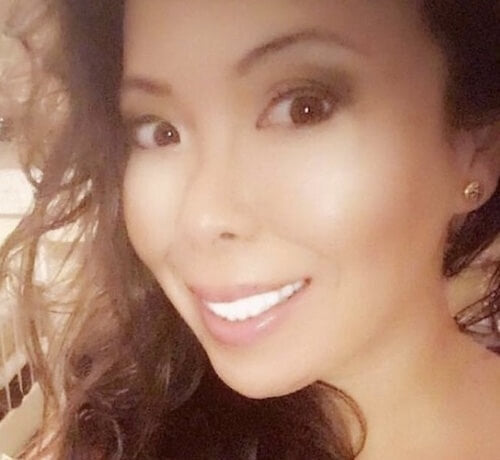With age comes wisdom — and the potential for changes to your hairline or hair loss. If you’ve noticed that your hairline isn’t looking quite the way it used to, you're not alone. A higher hairline or other changes in its shape are a natural progression as you age.
And while the word mature is usually considered to be a compliment, it may feel the exact opposite when it’s used to describe the hairline or anything having to do with your hair. To give you some peace of mind, here's exactly what a mature hairline is and seven ways to gracefully handle thinning hair. Plus, find out which products can help you combat thinning hair around your hairline.
#include-related-slider#
Your Hairline, Explained
The hairline is the edge of your hair, which outlines where your hair falls. Consider it the curtain for your hair, the frame of your face. Hairlines are distinctive and vary per person; they also tend to shift with age. However, there may be ways to alter the shape and/or height of your hairline.
Hairlines, including their shape and location on the scalp, are dependent on many factors, including hormones and lifestyle habits, along with other non-controllable elements like genetics and age. And, as age increases, it's not uncommon for the hairline to change.
Hairline Shape-Shifters
Hairlines vary in females versus males, with women having more variations than men. Here's a quick rundown of hairline shapes for each.
For women, the general guidelines for hairline shapes are as follows:
- Middle hairline: Average shape positioned mid-forehead
- Low hairline: Close to the eyebrows
- High hairline: Begins high up on the crown
- Straight-lined: Falls straight across — aka juvenile hairline
- Widow’s peak: Distinctive V-shape
- Bell-shaped: Either oval, round or bell-shaped
- Triangular hairline: Opposite of a widow’s peak
- Uneven hairline: One side may be slightly higher
- Receding or M-shape hairline: Less common in women than in men
Learn: Mature vs. Receding Hairlines — How to Spot the Differene
In men, hairline types tend to fall in the following shapes:
- Straight-lined: Falls straight across
- Cowlick: Grows in a direction opposite of surrounding hairs
- Low hairline: Starts close to eyebrows — most common in boys and young teenagers
- Middle hairline: Proportionate to forehead — can be rounded, straight or slightly asymmetrical
- Receding hairline: Progressively takes on appearance of high hairlines
Shop: GRO+ Advanced Hair Serum Kit
What Is a Mature Hairline?
A juvenile hairline is generally used to describe males in their teens who have a full head of hair. Typically between the ages 17 and 30, however, many men will develop a mature hairline, in which the hairline moves back about a half-inch to 1 inch from where it used to be. This is completely natural and not something to worry about.
A maturing hairline most frequently coincides with the descriptions of male pattern baldness and pattern hair loss associated with men. Hairline maturation tends to occur gradually over time and is rarely noticeable. In some people, this process can take up to 10 years. In others, it might occur more rapidly.
However, hair loss issues, including noticeable changes in the hairline, are equally concerning for women and are more common than you might think. According to the American Hair Loss Association, women are among 40% of those suffering from hair loss. For men or women struggling with hairline or hair loss issues, the experience can be stressful and impair self-confidence.
Read: What Causes Hair Loss? Every Trigger Explained
7 Ways To Handle a Mature Hairline
While stopping the clock is impossible, there are ways to at least pause the hands of time when it comes to the effects of the aging process on your hair. Here are some possible treatment options that work to prevent and potentially reverse hairline and hair loss issues.
1. Get a Head Start on Hairline Issues
“The earlier we intervene, the better, and it is also possible to reverse some of the hair loss sometimes," said Dr. Kenneth Mark, M.D., cosmetic dermatology expert and dermatologist. The doctor recommends using interventions such as shampoos that target hair thinning or hairline issues as a first step. In some cases, oral prescription medications may be needed.
However, as with any medication, there are risk factors to consider. Two of the most common hair loss ingredients found in some prescription treatments may cause negative side effects in some people. Additionally, those with certain underlying health conditions may be unable to take these medications. In that case, consider a natural alternative to help with hair issues. GRO More Kit includes both GRO Hair Serum and GRO Biotin Gummies to stimulate and promote healthier hair follicles with visible results in as soon as 90 days.
2. Mature Hairline vs Balding: Define the Difference
It's essential to establish whether hair issues are related to a mature hairline versus balding. Both maturing hairlines and male pattern baldness can often start very similarly, so it may be difficult to tell which is causing hair loss or receding of the hairline. However, there are some factors that set the two apart.
To identify a mature hairline, consider the following:
- Is there excessive shedding? Some hair loss is normal with a maturing hairline. It tends to occur in the shower and/or when styling your hair. However, if you’re losing more than 100 hairs a day, the issue may go beyond your hairline.
- Are areas around your temples extremely sparse? While a mature hairline does form an M-shape, it’s usually not extremely defined. Although your hairline may be moving back, areas around your temples that are extra sparse may be a sign of balding.
- Do the small hairs extend beyond your hairline? While everyone has some smaller hairs in the front of their hairline, an excessive amount of light, short hairs up front could be a sign of hair loss or male pattern baldness.
Remember that a mature hairline is completely normal. It does not mean you're going bald, nor does it indicate future balding hair loss.
3. Help for Hormonal Hair Loss
Hair loss, otherwise known as androgenetic alopecia, is also prevalent as we age. This is largely due to fluctuations in hormone levels. One such example: The hormone testosterone and its conversion into a molecule called DHT, which stands for dihydrotestosterone.
DHT is one of the most influential elements related to hormonal hair loss. This process causes the hair follicles to shrink, resulting in hair loss. Choosing to utilize DHT blockers in both your hair care and daily lifestyle routines can help promote healthier hair, inhibit future hair loss and even may help your hair grow more quickly.
4. Switch Up Your Style
Changing up your day-to-day hairstyles can also help minimize the potential of hair loss or damage to hairlines. Pulling your hair back in a too-tight ponytail or bun or another hairstyle that pulls on the hair can lead to friction, damage and hair loss.
This type of hair loss, known as traction alopecia, is a result of prolonged and repetitive pulling on your hair that inflames the hair follicles. It may also be caused by using chemical relaxers or rollers. Give your hair — and scalp — a break by wearing your hair loose and down.
Read: This Is What You Need To Know About Traction Alopecia
5. Consider Alternative Therapies
According to Dr. Mark, other alternative therapies such as platelet-rich plasma show promise for those dealing with a maturing hairline issue.
“It is a very promising treatment!" said Dr. Mark. "PRP is where you draw the patient's blood, spin it down for the centrifuge and then inject the platelet-rich plasma component."
Some studies indicate that PRP injections have increased hair count and density in patients with both androgenetic alopecia and alopecia areata. The treatment may also help in increasing blood supply to hair follicles, thereby leading to an increase in hair thickness.
Related: What You Should Know About PRP
6. Go Natural
Pick the power of plants (aka nature's medicine) to treat hair loss without the scary side effects or potential risks of chemical medications.
"A B multivitamin is also a key component to my hair growth regimen," said Dr. Mark.
Choose plant-powered supplements that include essential vitamins, minerals, nutrients and probiotics. Other options such as saw palmetto, pumpkin seed oil, red clover and biotin can help address hair issues, healing the scalp and hair follicles the natural way to promote healthier looking hair.
- Biotin, found in GRO Biotin Gummies, also includes folic acid and vitamins B-5, 6 and 12 to help support your body’s production of keratin and collagen for healthier, stronger hair.
- Red clover, which is included in GRO Hair Serum, can help reduce signs of hair shedding and increase the appearance of hair density.
- Saw palmetto has natural anti-inflammatory properties to soothe scalp issues and prevents the conversion of testosterone into DHT.
- Pumpkin seed oil can also help inhibit the DHT conversion; applying the oil topically may also condition and add shine to your hair.
Related: This Is the Best Time to Take Probiotics
7. Integrate Overall Wellness
Build a healthy daily lifestyle by incorporating holistic wellness into your schedule each day. Integrate healthy habits that minimize stress. Include mindful movement such as yoga for sleep and yoga for digestion. Practice self-care, reduce digital screen time, spend time outdoors and communicate with loved ones each day. Finally, and perhaps the most important for overall health is to focus on caring for both your emotional and physical wellness — including the wellness of your hair.
More from VEGAMOUR
- How To Be More Mindful Starting Right Now
- 9 Biotin-Rich Vegan Foods To Eat for Healthy Hair
- How to Care for Your Hair in Your 60s
- Trend Alert: Hairline Microblading
Photo credit: Marcus Aurelius/Pexels
Back


















